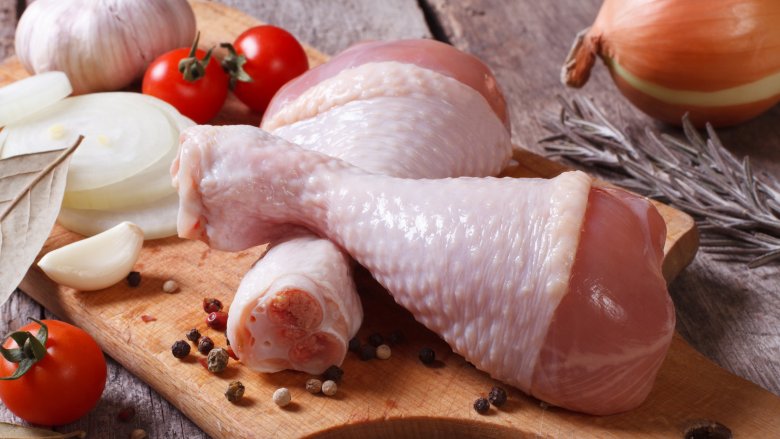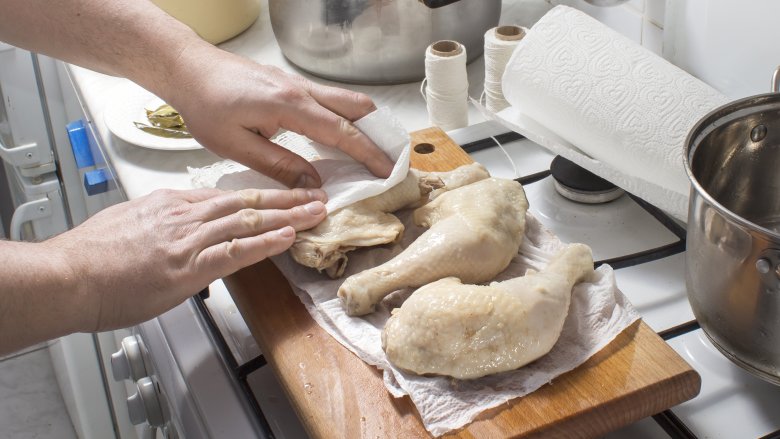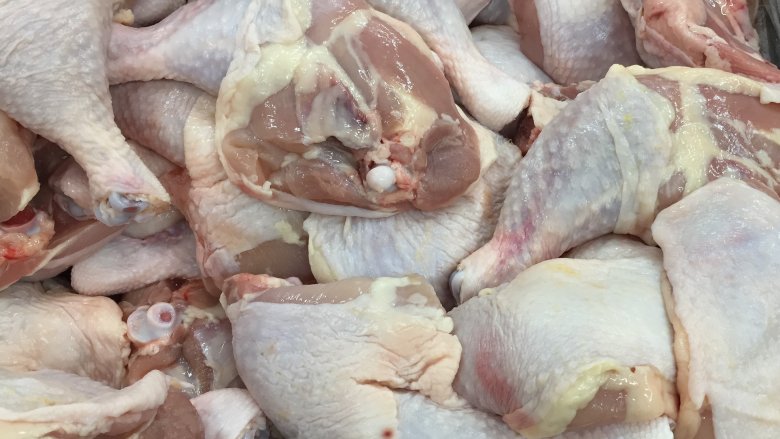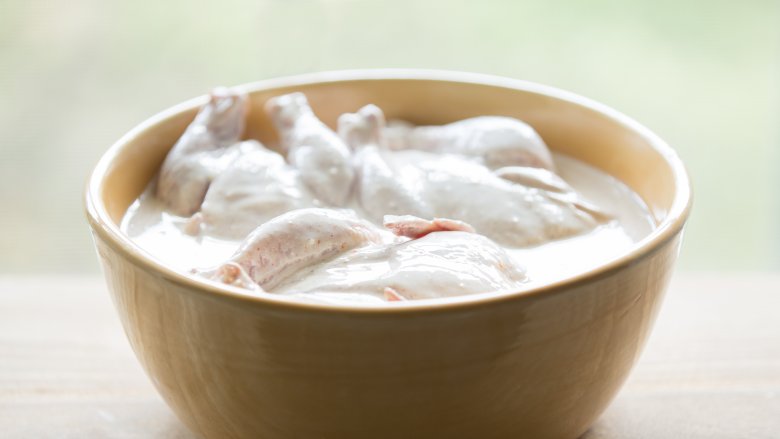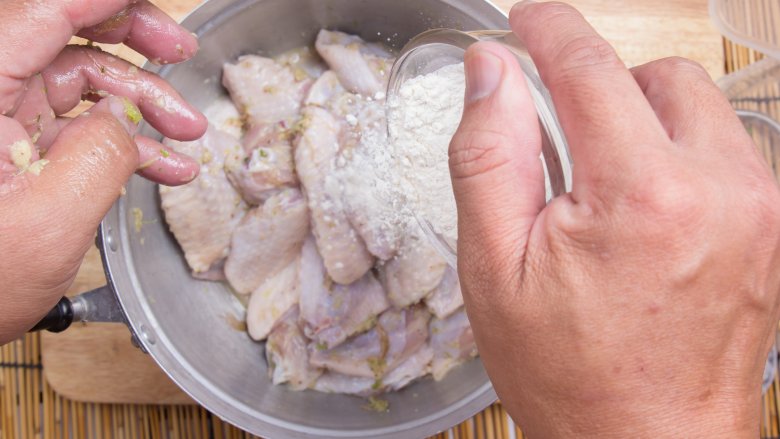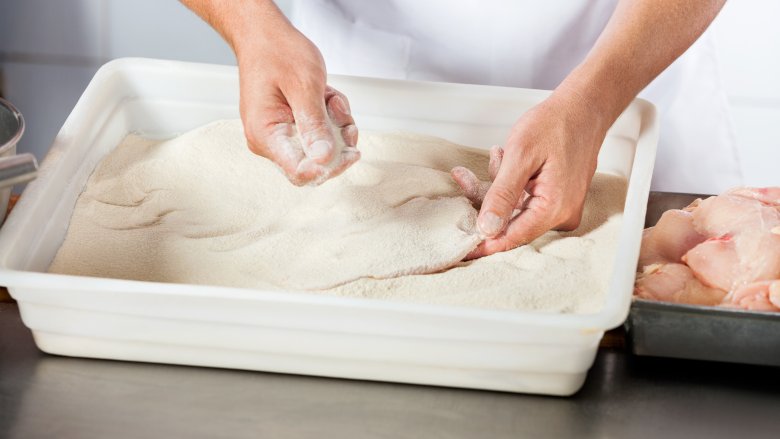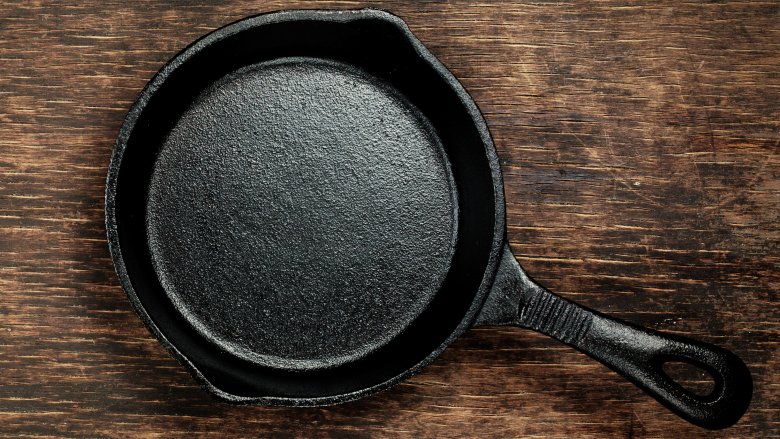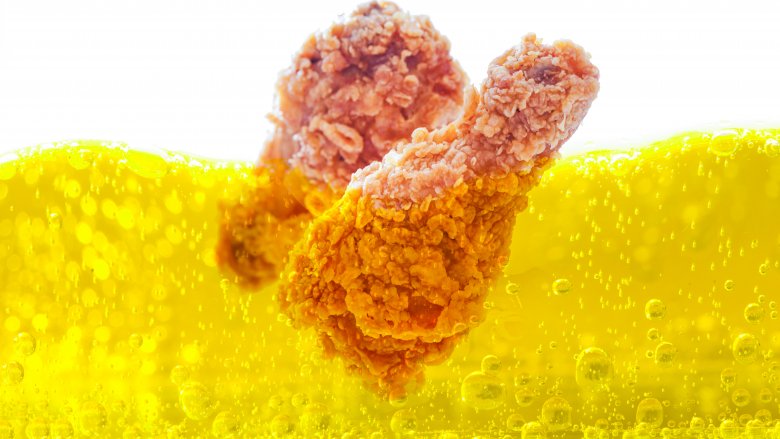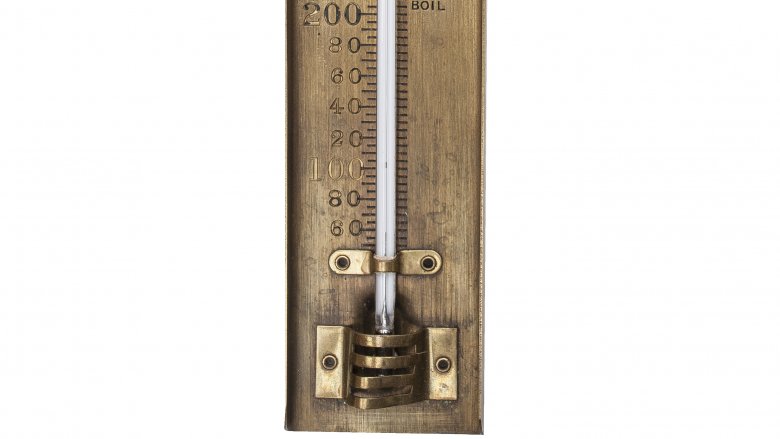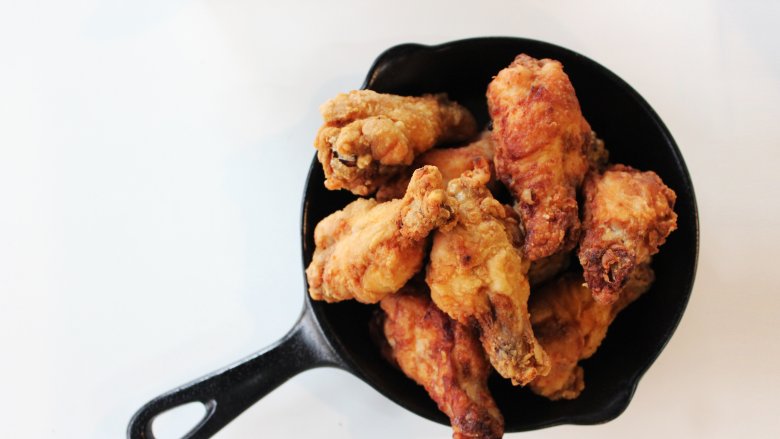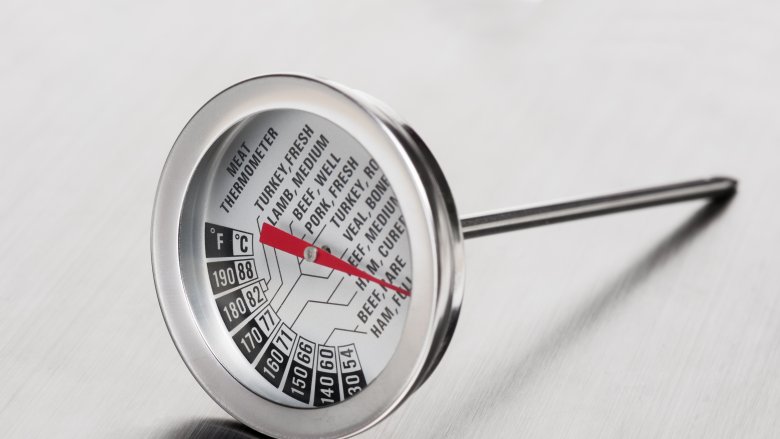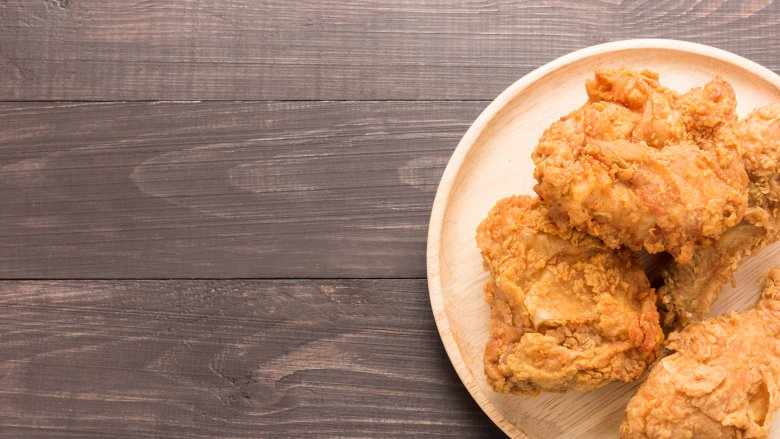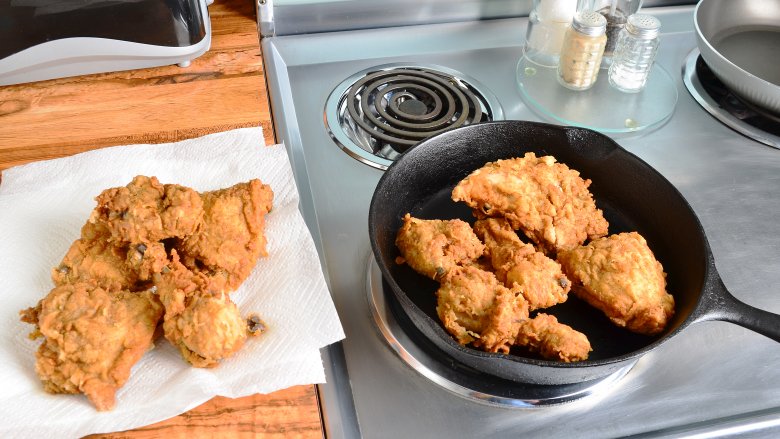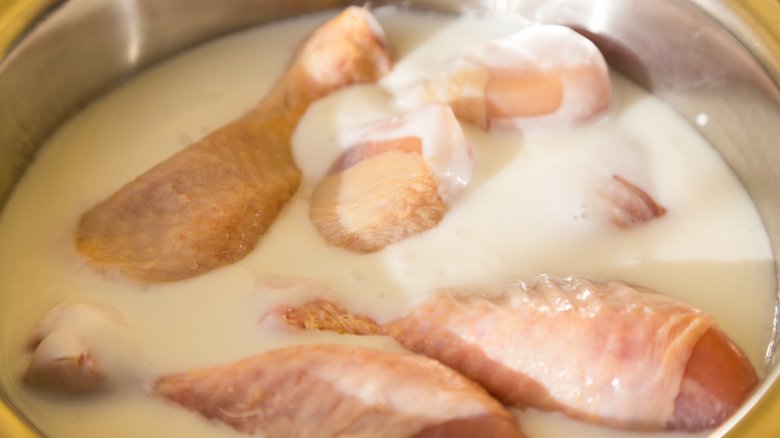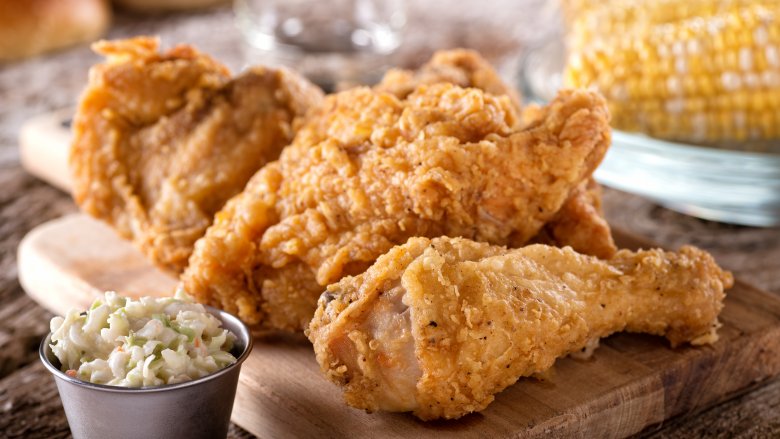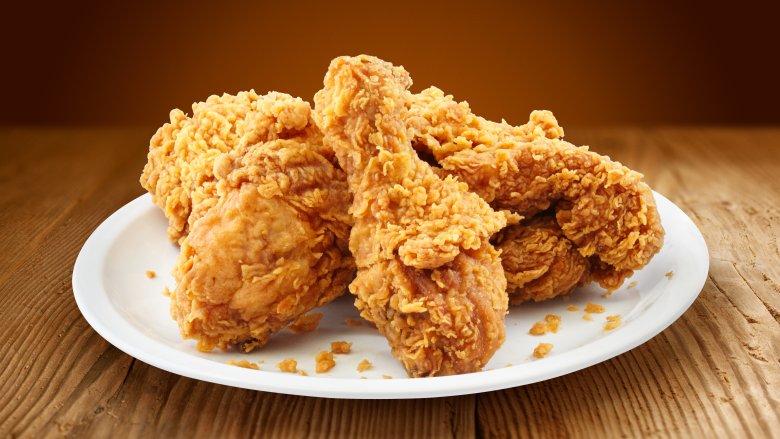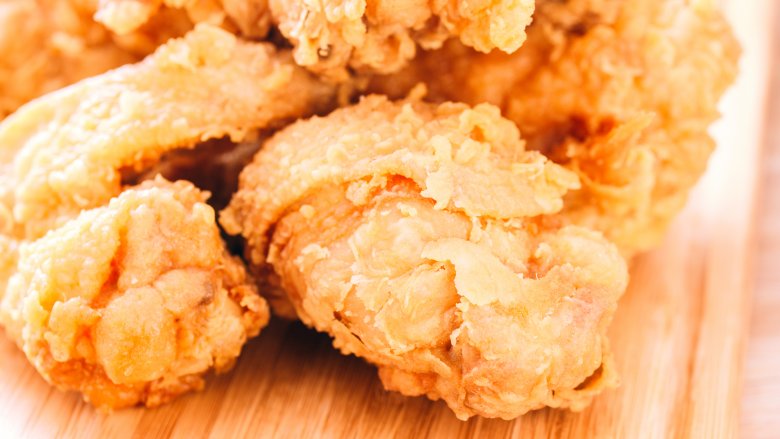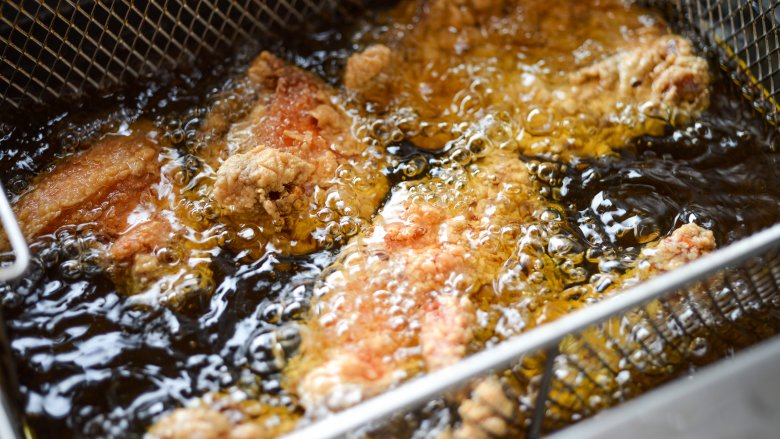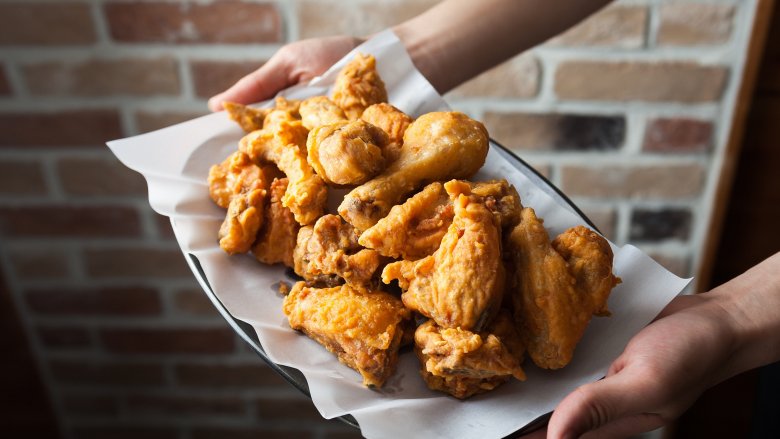Ways You're Screwing Up Your Fried Chicken
We may receive a commission on purchases made from links.
Let's be honest — as amazing as fried chicken is, it is a total pain to make. And to make perfectly? Well, that's usually best left to southern grandmothers with an enviable array of cast iron skillets that are more non-stick than any of your actual non-stick pans.
While it is true that perfect fried chicken takes a little know-how, a bit of skill, a fair amount of patience, and most definitely requires a good amount of cleanup, it is possible to unlock this culinary achievement if you right all the wrongs you've been making. Are you using flour or cornstarch for breading? Are you cooking it covered or uncovered? Are you draining it on a rack or on paper towels? Each of these potentially incorrect answers could be the difference between ho-hum fried chicken and make-a-southern-grandma-proud fried chicken.
It might sound like a lot to think about for such a seemingly basic dish, but one bite of the best fried chicken you've ever made will convince you that all this attention to detail is more than worth it in the end.
You're cooking cold chicken directly from the fridge
Take chicken from fridge, dredge, and fry, right? Nooo! Before you do anything to the chicken at all, please let it sit at room temperature for at least 30 minutes. When you fry cold chicken, that coldness causes the temp of the oil to drop drastically. As a result, the chicken cooks unevenly. You definitely don't want that.
You're not drying the chicken well
Okay, patting your chicken pieces dry with paper towels seems like a small, inconsequential step on the surface, but it's actually quite important to do before you get to the dredging stage. By ensuring the surface of the chicken is completely dry, you get a perfect even coating of flour to stick instead of irregular lumps all over.That's my two cents.
You're not using all the chicken parts
Sure, the fried chicken emoji on your iPhone is a drumstick, but that doesn't mean you should only fry up drumsticks! You should make use of all the chicken parts. For large breast pieces, be sure to cut them into smaller pieces so they can cook evenly and at the same rate as the other pieces.
You're not using a brine
If you don't want to end up with dry, tasteless chicken, do yourself a favor and be sure to use a brine. Why waste your time with brining? For one thing, it's a surefire way to make any meat cook up tender and succulent. While the practice of soaking meats in salted water may have been used in the pre-refrigeration days as a way to preserve them, the method is just as useful today for rendering better tasting meat. The soaking time may seem long and wear on your patience, but it's well worth it to let that flavorful liquid seep into your chicken over hours before it hits the frying pan. In addition to adding moisture to your chicken meat, the brine injects salt into the meat, essentially breaking down the proteins and tenderizing it. Don't skip this crucial step!
You're not seasoning the flour for dredging
In addition to seasoning your brine, be sure to season the flour as well. Your goal is to have flavorful meat and crust. While you can season the dredging flour with whatever spices your heart desires, at the very least you ought to use a liberal amount of good kosher salt and freshly ground black pepper.
You're dredging the chicken in too much flour
Fried chicken is best with a light coating of flour. You're going for that light, crispy, addictive crust. No need to dip your chicken in flour more than once. Using too much flour for dredging results in wet, soggy, greasy crust. Simply throw your seasoned flour into a large resealable plastic bag, add the chicken pieces, and shake gently—once!
You're using a large pot for frying
While you may think you need to lug out your biggest pot in order to fry the chicken in gallons of oil, you might be surprised that a big pot isn't necessary for small-batch frying. Unless you're making enough fried chicken to service a large crowd, a cast-iron skillet with high sides will do just fine. This way you can easily flip the pieces without scary oil splatters. Yikes.
You're using the wrong oil for frying
Be sure to fry your chicken in oils with high smoking points. Generally speaking, refined oils are ideal for frying as they have higher smoking points. The smoking point simply refers to the temp at which the oil starts to break down and emit unpleasant fumes. Sesame, peanut, and canola oils are all great for frying chicken. Extra virgin olive oil, not so much.
You're frying the chicken at the wrong temp
Frying chicken at the wrong temp can result in all sorts of sad feelings. Frowny faces often ensue when a cook ends up with burnt crust, undercooked meat, dry meat, or soggy crust. The best way to remedy this is to invest in a cooking thermometer to make sure you're cooking fried chicken at the right temp, which between 300 and 325 degrees Fahrenheit. At this heat, the chicken gets a nice crisp crust (no burning) and the inside is delightfully cooked through.
You're leaving the pan uncovered during cooking
If you're not covering your pan during frying, you may find that your chicken isn't as crisp as it could be, or not as evenly cooked. As the chicken fries, pop a lid on top. Doing so encapsulates the heat and helps the chicken fat render, yielding deliciously crisp-on-the-outside, moist-on-the-inside fried chicken. I mean, isn't that what we all want?
You're overcrowding the pan
One of the keys to even cooking is avoiding an overcrowded pan. This goes for veggies, meat, and fried chicken. Work in batches in order to leave plenty of space between chicken pieces. You want to have ample room for flipping the chicken pieces to ensure they are an irresistible golden brown all over.
You're not properly checking the chicken for doneness
While you may think you can eyeball the doneness of fried chicken, you can't. Depending on the temperature of the oil, the chicken could appear done on the outside due to overzealous browning but in fact, still be raw on the inside. Chicken should be cooked to an internal temperature of 165 degrees Fahrenheit. Don't risk eating undercooked poultry, okay? Please get yourself a meat thermometer and make sure your fried chicken is safe to eat.
You're not letting the chicken rest after cooking
Biting into hot fried chicken is tempting, but you're better served if you wait. You won't burn your mouth eating piping hot meat, plus the resting time gives the juices a chance to redistribute, rewarding you with super juicy chicken. This is all for the best.
You're letting the oil drain on paper towels
While many of us instinctively drain fried foods on paper towels so they can absorb the excess oil, fried chicken should be drained on wire cooling rack. Letting those crispy chicken pieces sit on a wad of paper is one surefire way to create steam, resulting in soggy crust syndrome. After all that hard work? No thank you.
You're not using buttermilk
A salt-water brine is one way to go when it comes to producing juicy, tender fried chicken, but for all the good it does, there is a drawback to consider: The brine penetrates into the chicken so much that you end up with a very wet result, meaning that you're tasked with drying each piece of chicken thoroughly before breading and frying to ensure a crisp exterior. If you don't want to deal with that, you might want to turn to buttermilk.
Robby Melvin, Time Inc. Food Studios recipe developer, tells MyRecipes, "Soaking chicken in buttermilk acts as a brine" thanks to its fats and acids that help break down the chicken. Another plus? The buttermilk bath is a good way to ensure your breading stays put since it clings to the chicken and gives the flour something to adhere to. And don't worry about a missed opportunity to add flavor. Just like a brine, you can enhance a buttermilk marinade by adding hot sauce or herbs and spices to give your fried chicken that little something extra.
You're not using cornstarch
All-purpose flour might be the standard ingredient when it comes to coating fried chicken, but if you're not adding cornstarch, you're missing out on an opportunity to take your crust to the next level.
According to The Kitchn, it's the secret ingredient your breading needs. When you add cornstarch to the all-purpose flour, the end result is crispier than with flour alone. That's because cornstarch "weakens the all-purpose flour's protein" and makes it tender. Bon Appétit recommends using a 50/50 ratio of cornstarch to all-purpose flour, and promises that it will give your fried chicken an "audibly crunchy, beautiful browned exterior."
Some prefer to skip the flour altogether and use only cornstarch, like famed chef Ludo Lefebvre. He makes sure to get a thick layer of cornstarch on the chicken by really pressing it into the meat, and told Food & Wine that his go-to method produces a coating with a "nice, big flake."
Whether you go all-in, or just half-and-half, cornstarch is a fried chicken game-changer.
You're not using KFC's purported secret ingredient
KFC's secret formula has been debated for years, and with the apparent discovery of the 11 herbs and spices in 2016, it seemed that we might finally be able to recreate our favorite fried chicken in the comfort of our own kitchens. But according to the Chicago Tribune, those 11 spices and herbs alone didn't yield the exact taste of KFC's iconic original fried chicken recipe. Until a secret ingredient was added...
The ingredient? Accent, an MSG flavor enhancer. Tribune reporter Joe Gray writes that it wasn't until the fried chicken was sprinkled with Accent that it tasted just like the Colonel's. "Our chicken was virtually indistinguishable from the batch bought at KFC," he explains.
Could an MSG-based product really be the secret? According to its product description, Accent is the "secret ingredient" used by many chefs, and a check of KFC's ingredient list confirms that MSG is indeed included in their original fried chicken recipe. Given that MSG gives foods that umami factor, it definitely makes some sense. Ron Douglas, author of America's Most Wanted Recipes, says that you can either add Accent to your seasoning mix, or simply sprinkle it over the finished product right out of the fryer — just don't skip it.
You're not breading it the day before
The best part of fried chicken is obviously the crispy, crunchy exterior. But how many times have you taken your first bite only to have all that crispy, crunchy crust shatter into a million pieces? Sure, you can scrape it off your plate with each subsequent bite of chicken, but its preferred location is on the chicken itself.
Logically thinking, it would seem like the sooner you get the breaded chicken into the hot oil, the better your chances of a superior crust, right? Not according to executive chef Ben McLean, who says this will only ensure all that glorious crust falls off with that first bite. The way around that? He spills his secret to The Takeout, explaining, "What we do is once we bread it, we let it sit on a rack in the fridge and let air circulate overnight. It'll allow the moisture of the chicken to soak through the breading, and it makes it super tacky, allowing the breading to stick to the meat itself."
You're not double-frying it
Frying chicken just one time is a pretty big pain — we get it. But if you've already committed to the oil and the splatter and the mess, frying the same chicken a second time really isn't that big of a deal, is it?
Serious Eats explains that one of the biggest problems with cooking fried chicken is that in order to get the crust as crunchy as possible, you've got to cook it for a long time, and in the process of getting that extra-crispy crust, you end up overcooking the meat. No matter how amazing your crust is, nobody will want the dried out chicken underneath. To combat this conundrum, give your chicken its usual dunk in the hot oil, then remove it as you normally would (just don't overcook it). Let the chicken pieces sit for at least 30 minutes, and then fry it again. This way, the meat has had a chance to cool down, and the second trip to the oil bath won't do any harm — it will just make your crust unbelievably crunchy.
You're reheating it wrong
There's no greater sin than to subject your leftover fried chicken — which you worked so hard to perfect — to the microwave. Try as you might, there's just no way to nuke that cold, soggy chicken back to its former crispy, crunchy glory. To properly reheat your fried chicken you need to use an oven, which seems fairly straightforward, but there are a few tricks to ensuring that it's just as good as when you pulled it out of the fryer the first time.
Fair warning here: You do need to plan ahead, because the chicken should sit out for a 30 minutes to 1 hour at room temperature before reheating. This guarantees that all the differently-sized pieces will heat evenly. Once the chill is off, put the chicken on top of a wire rack on a baking sheet, and cook in a 400 degree oven. Time will vary depending on the size of the pieces; around 16 minutes for breasts, and 12 minutes for legs and thighs.
